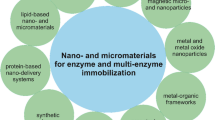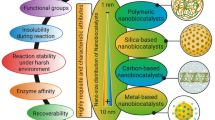Abstract
Supported or modified enzymes in the form of mobile nanoparticles are designed for enhanced activities and stabilities; however, their practical operations are dwarfed due to their tiny size which always makes recycling an arduous task and a potential risk to the environment. To overcome such drawbacks, this chapter describes a method for the preparation of a new form of microcapsules, possessing single-cavity compartments and nano-pores in the shell, to encage nanoparticle-based biocatalysts and form cell-like microreactors (CLMRs). The encaged nanoscale catalysts are maintained their high activities as in a bulk-phase solution, while they could be handled as materials of sizes hundreds-fold larger.
Access this chapter
Tax calculation will be finalised at checkout
Purchases are for personal use only
Similar content being viewed by others
References
Jia, H., Zhu, G., and Wang, P. (2003) Catalytic behaviors of enzymes attached to nanoparticles: The effect of particle mobility. Biotechnol. Bioeng. 84, 406–414.
Kang, K., Kan, C., Du, Y., and Liu, D. (2005) Synthesis and properties of soap-free poly(methyl methacrylate-ethyl acrylate-methacrylic acid) latex particles prepared by seeded emulsion polymerization. Eur. Polym. J. 41, 439–445.
Wang, P. (2006) Nanoscale biocatalyst systems. Curr. Opin. Biotechnol. 17, 574–579.
Kim, J., and Grate, J. W. (2003) Single-enzyme nanoparticles armored by a nanometer-scale organic/inorganic network. Nano Lett. 3, 1219–1222.
Kim, J., Grate, J. W., and Wang, P. (2006) Nanostructures for enzyme stabilization. Chem. Eng. Sci. 61, 1017–1026.
Colvin, V. L. (2003) The potential environmental impact of engineered nanomaterials. Nat. Biotechnol. 21, 1166–1170.
Kim, J., Jia, H., Lee, C.-W., Chung, S.-W., Kwak, J. H., Shin, Y., Dohnalkova, A., Kim, B.-G., Wang, P., and Grate, J. W. (2006) Single enzyme nanoparticles in nanoporous silica: A hierarchical approach to enzyme stabilization and immobilization. Enzyme Microb. Technol. 39, 474–480.
Fan, C.-H., and Lee, C.-K. (2001) Purification of D-hydantoinase from adzuki bean and its immobilization for N-carbamoyl-D-phenylglycine production. Biochem. Eng. J. 8, 157–164.
Ma, G.-H., Su, Z.-G., Omi, S., Sundberg, D., and Stubbs, J. (2003) Microencapsulation of oil with poly (styrene-N,N-dimethylaminoethylaminoethyl methacrylate) by SPG emulsification technique. J. Colloid Interface Sci. 266, 282–294.
Ma, G.-H., Chen, A.-Y., Su, Z.-G., and Omi, S. (2003) Preparation of uniform hollow polystyrene particles with large voids by a glass-membrane emulsification technique and a subsequent suspension polymerization. J. Appl. Polym. Sci. 87, 244–251.
Okubo, M., and Minami, H. (1996) Control of hollow size of micron-sized monodispersed polymer particles having a hollow structure. Colloid Polym. Sci. 274, 433–438.
Ma, G.-H., Omi, S., Dimonie, V. L., Sudol, E. D., and El-Aasser, M. S. (2001) Study of the preparation and mechanism of formation of hollow monodisperse polystyrene microspheres by SPG (Shirasu Porous Glass) emulsification technique. J. Appl. Polym. Sci. 85, 1530–1543.
Okubo, M., Konishi, Y., and Minami, H. (2004) Production of hollow particles by suspension polymerization of divinylbenzene with nonsolvent. Progr. Colloid Polym. Sci. 124, 54–59.
Okubo, M., Konishi, Y., Inohara, T., and Minami, H. (2002) Production of hollow polymer particles by suspension polymerizations for ethylene glycol dimethacrylate/toluene droplets dissolving styrene-methyl methacrylate copolymers. J. Appl. Polym. Sci. 86, 1087–1091.
Im, S. H., Jeong, U., and Xia, Y. (2005) Polymer hollow particles with controllable holes in their surfaces. Nat. Mater. 4, 671–675.
George, M., and Abraham, T. E. (2006) Polyionic hydrocolloids for the intestinal delivery of protein drugs: Alginate and chitosan – A review. J. Control. Release 114, 1–14.
Seifriz, W. (1925) Studies in emulsions. III–V. J. Phys. Chem. 29, 738–749.
Zydowicz, N., Nzimba-Ganyanad, E., and Zydowicz, N. (2002) Polym. Bull. 47, 457–463.
Liu, R., Ma, G., Meng, F.-T., and Su, Z.-G. (2005) PMMA microcapsules containing water-soluble dyes obtained by double emulsion/solvent evaporation technique. J. Control. Release 103, 31–43.
Meng, F. T., Ma, G. H., Qiu, W., and Su, Z. G. (2003) W/O/W double emulsion technique using ethyl acetate as organic solvent: Effects of its diffusion rate on the characteristics of microparticles. J. Control. Release 91, 407–416.
Engel, R. H., Riggi, S. J., and Fahrenbach, M. J. (1968) Insulin: Intestinal absorption as water-in-oil-in-water emulsions. Nature 219, 856–857.
Ficheux, M.-F., Bonakdar, L., Leal-Calderon, F., and Bibette, J. (1998) Some stability criteria for double emulsions. Langmuir 14, 2702–2706.
Florence, A. T., and Whitehill, D. (1981) Some feature of breakdown in water-in-oil-in-water multiple emulsions. J. Colloid Interface Sci. 79, 243–256.
Shum, H. C., Lee, D., Yoon, I., Kodger, T., and Weitz, D. A. (2008) Double emulsion templated monodisperse phospholipid vesicles. Langmuir 24, 7651–7653.
Wang, P., Sergeeva, M. V., Lim, L., and Dordick, J. S. (1997) Poly(methyl methacrylate) hollow particles by water-in-oil-in-water emulsion polymerization. Nat. Biotechnol. 15, 789–793.
Omi, S., Katami, K. I., Taguchi, T., Kaneko, K., and Iso, M. (1995) Synthesis of uniform PMMA microspheres employing modified SPG (Shirasu Porous Glass) emulsification technique. Macromol. Symp. 92, 309–320.
Omi, S., Katami, K. I., Taguchi, T., Kazuyoshi, K., and Iso, M. (1995) Synthesis and applications of porous SPG (Shirasu Porous Glass) microspheres. J. Appl. Polym. Sci. 57, 1013–1024.
Omi, S. (1996) Preparation of monodisperse microspheres using the Shirasu porous glass emulsification technique. Colloid Surf. A-Physicochem. Eng. Asp. 109, 97–107.
Zhou, W.-Q., Gu, T.-Y., Su, Z.-G., and Ma, G.-H. (2007) Synthesis of macroporous poly(glycidyl methacrylate) microspheres by surfactant reverse micelles swelling method. Eur. Polym. J. 43, 4493–4502.
Wang, R.-W., Zhang, Y., Ma, G.-H., and Su, Z.-G. (2006) Modification of poly(glycidyl methacrylate-divinylbenzene) porous microspheres with polyethylene glycol and their adsorption property of protein. Colloid Surf. B-Biointerfaces 51, 93–99.
Acknowledgments
The authors thank the National Basic Research Program of China (New 973 Program, Contract Nos. 2009CB724705) and Chinese National Science Foundation of China (20576135, 20536050, and 20728607) for their support. The support from Chinese Academy of Sciences for international collaboration is also greatly appreciated.
Author information
Authors and Affiliations
Corresponding author
Editor information
Editors and Affiliations
Rights and permissions
Copyright information
© 2011 Springer Science+Business Media, LLC
About this protocol
Cite this protocol
Gao, F., Wang, P., Ma, G. (2011). Microencapsulation of Bioactive Nanoparticles. In: Wang, P. (eds) Nanoscale Biocatalysis. Methods in Molecular Biology, vol 743. Humana Press. https://doi.org/10.1007/978-1-61779-132-1_13
Download citation
DOI: https://doi.org/10.1007/978-1-61779-132-1_13
Published:
Publisher Name: Humana Press
Print ISBN: 978-1-61779-131-4
Online ISBN: 978-1-61779-132-1
eBook Packages: Springer Protocols




